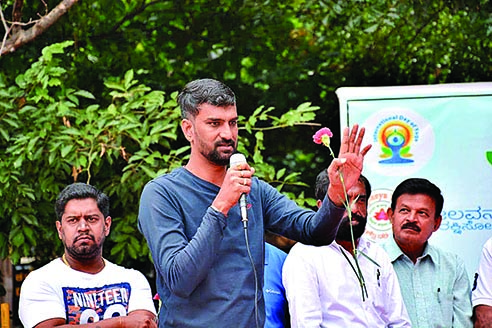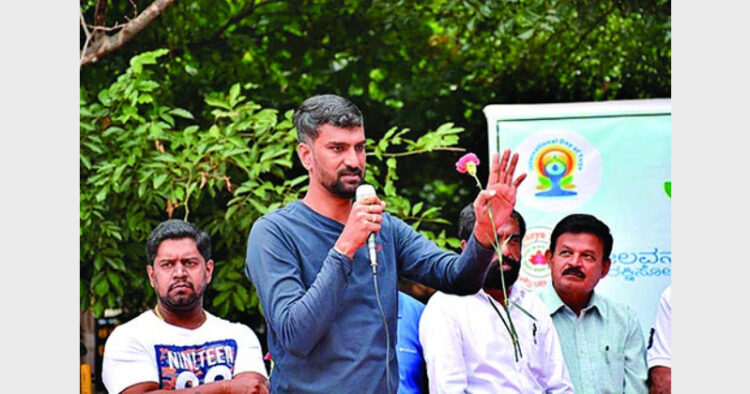– Anand Malligevad, Lake Expert and conservationist
Anand Malligevad aims to restore 45 lakes in and around Bengaluru by 2025 and thereby contribute to solving the water crisis the city is staring at. Given his success and the model of lake restoration, Anand is much in demand from city corporations and like-minded people and organisations in other cities. Anand spoke to Organiser on his work, the importance of lakes in urban environments, his model of lake rejuvenation and way forward. Excerpts:

What inspired you to take up the task of cleaning the lakes?
More than inspiration, I see my work as a necessity. In 1996, Bengaluru had groundwater available at 200 feet and today it has gone down to nearly 1200 feet. Five years ago I realised the consequences of the city running out of groundwater by 2020. Nobody had worked on lake rejuvenation for me to look up as an inspiration or a model. I then studied the lakes and realised that lakes are the lifeline for Bengaluru as the nearby rivers had either dried up or become contaminated. Then I took up an urban lake which was spread over 36 acres and signed an MoU with the government of Karnataka for its restoration. Instead of jumping into the task of restoration using earlier methods, I studied the ecology and biodiversity of the lake for a considerable time to find and work on a unique solution.
What as per your observation are the causes for degradation of our water bodies, especially in cities?
The most significant cause of lake degradation is the lack of rainwater harvesting. Moreover, 60-70% of the rainwater that feeds our urban lakes are filled with sewage and is discharged in a unplanned manner. In our homes and offices, we don’t filter gray water (wastewater without fecal contamination) before it reaches drains. Unfiltered gray water flows to the lakes through the drains and contaminates the lakes. Water from Industry, hotel, etc. should be filtered in check bunds which have filtration incorporated in them. Hydrophonics can also be used to purify water which will also beautify the environment along with increasing cross-pollination and ecology will be healthy. When clear water reaches our lakes, the ecosystem will be healthy and the aquatic life there will also thrive. Such lakes will also rejuvenate the nearby aquifers which have fed our traditional wells and stepped tanks. When we have natural purifying systems, we don’t need concrete solutions like large STPs which are temporary solutions and require a lot of maintenance.
Lakes in Bengaluru are contaminated because the water that feeds them is polluted. I have used natural solutions in purifying water that feeds Kyalasanahalli lake, which can be consumed directly. I have used 65 varieties of plants in the lake to purifyHow did you go about the task of rejuvenation of lakes when even city corporation has failed?
Lakes in Bengaluru are contaminated because the water that feeds them are polluted. I have used natural solutions in purifying water that feeds Kyalasanahalli lake, which can be consumed directly. I have used 65 varieties of plants in the lake to purify. Further, I have designed a separate solution for each lake. The Gavi lake is designed on the concept of a step-well (Kalyani). Vabasandra lake is on the reservoir concept. Kyalasanahalli lake is designed on the ecology of the location. My design is 60% water body and 40% forests. We have planted 115 varieties of trees, 23 varieties of medicinal plants, 30-40 native species of flowers.
When I first started, I was the only one to rejuvenate lake in a city in an individual capacity. We must understand that cleaning and rejuvenation are two different issues. Cleaning involves only removing weeds and hyacinth. I designed the solutions based on the hydrology and geology of the lake. We created inlets and outlets, dug up raj-nullahs and cleared water flow to the lake. After my rejuvenation work on the Kyalasanahalli lake, within 9 days, 22 feet of crystal clear water filled the lake.
Despite such natural solutions and ancient models available for maintenance of lakes, what is that which has brought us to this condition?
The solutions I have designed are not invented by me. The answers are all around us but it is we who are not serious. All we do is to dump material and link drains to a lake. In the name of rejuvenation, all we do is to remove weeds, build a bund, a jogging track and a garden with lights. As widely thought, there is no ocean below the earth. All the groundwater we have is the rainwater and streams that percolate and lakes are the primary sources for that.
Any solution has to be self-sustainable and should involve local people. The lake should be a natural habitat where man and animals use it daily. Cattle should feed on the grass and its dung is natural manure. In my model, I have planted 38,000 saplings which have now grown and have not used any fertiliser
How can we make lake rejuvenation a sustainable model?
Any solution has to be self-sustainable and should involve local people. The lake should be a natural habitat where man and animals use it daily. Cattle should feed on the grass and its dung is natural manure. In my model, I have planted 38,000 saplings which have now grown and have not used any fertiliser. During the last two years, I have created Miyawaki forests which grow 30 times faster. These forests have 186 varieties of trees whereas Bengaluru today have only about 45 varieties of trees. I have also planted Orila saplings which is a dominant species and will not allow the growth of weeds and parthenium. A thriving lake with good aquatic life is also a good source for birds.
What should be done to create awareness about the rejuvenation of water bodies among common people and government agencies? What are your future plans?
I have been visiting institutes, schools and companies to showcase my work. When they see your success stories, they get involved. We do not need to create awareness about water conservation as it is a basic commodity that everyone needs and are aware of the threats. Social media and visual media can do an excellent job of educating people. We also need to connect people and give them something that they can cherish for long. I am in 133 lake committees and helping the government plan at a micro level. By 2025 I aim to rejuvenate 45 lakes and plant 45 lakh trees. The green corridor that I have envisioned will be the largest man-made amazon like forest. I also want to establish World’s first ecological research institute.













Comments